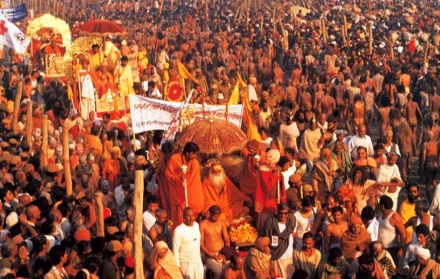The largest gathering of humanity is taking place in Allahabad, in northern India. The Kumbh Mela is the world’s biggest religious event, often called the “greatest show on earth“, a unique event that blends religious and cultural features, in an atmosphere saturated with the scent of burning incense, and the sound of chiming bells, Vedic hymns and mantras, and the beating of countless drums.
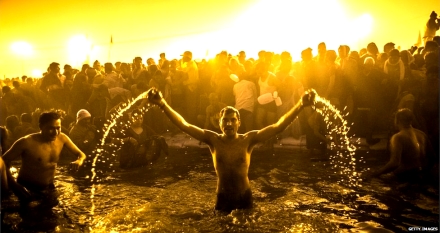
More than 100 million people are expected to attend the two month festival and bathe in the waters of the Ganges River, most of them camping on the white sands of the river. For more than 2,000 years, the festival has been the main meeting point for the Hindu sadhus or holy men, some of which live in remote forests or Himalayan caves and rarely get out in public. The Kumbh Mela gives people the opportunity to meet with the devotees of the various religious orders, and learn from the many religious teachers and spiritual masters. The ancient festival grows in size each time it is held, reflecting India’s expanding population and thriving spiritual life.
The first day of the Kumbh Mela was marked by processions of holy men riding ornately decorated chariots and elephants, surrounded by marching bands. “The silence of the chilly mornings is broken with the beating of drums and other musical instruments,” explained Allahabad resident Vinita Khare to the Times of India.
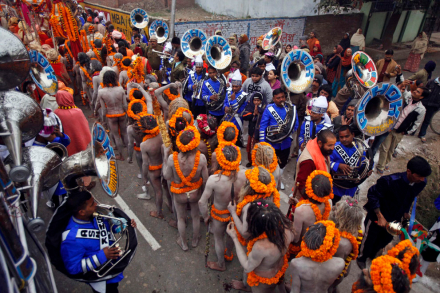
The festival (or mela) has its roots in a Hindu tradition that says the god Vishnu wrested from demons a golden pot (or kumbh) containing the nectar of immortality. In a twelve day fight for possession, four drops fell to earth, in the cities of Allahabad (at the confluence of the Ganges River, the Yamuna River, and mythical Saraswati River), Haridwar (where the Ganges River enters the plains from Himalayas), Ujjain (on the banks of Ksipra River), and Nasik (on the banks of Godavari River). Every twelve years a Kumbh Mela is held at one of these spots, with the festival at Allahabad considered the most sacred of them all.
The Kumbh Mela begins on Makar Sankranti, the day when the Sun and Moon enter Capricorn and Jupiter enters Aries, considered an especially auspicious time which allows the soul to easily enter the celestial world. There are three different kinds of Kumbh Mela: an ardh (or half) kumbh is held every six years, a purna (full) kumbh is held every 12 years, and a maha (great) kumbh that happens after 12 purna kumbhs every 144 years. The 2013 gathering is a Maha Kumbh Mela, which occurs only at Allahabad.
The Maha Kumbh Mela began on the new moon on January 14th, and continues until the full moon of February 25th. The new moon of February 10, 2013 is the main bathing date, while the full moon of January 27th is also very significant. February 10th is called the “New Moon of the Saints”, and is a day when new members of various religious orders receive their first initiation, joining more than fifty million people who will bathe on that day.
“I wash away all my sins, from this life and before,” said wandering ascetic Swami Shankranand Saraswati, 77, shivering naked in the cold. He gave up a career as a senior civil servant to become a holy man, and for decades ate only nuts and fruit.
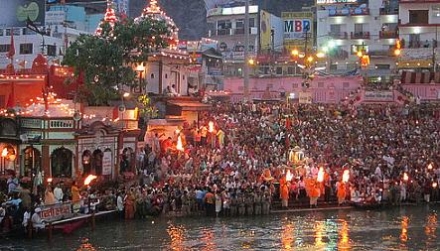
The festival attracts an increasing number of global followers, and for the first time is being marketed as a tourist destination. This year also features computer applications to help navigate the festival, and cyber cafes around the site. But overall, the festival hasn’t changed much in thousands of years. Pilgrims still make their way there without advertising, and there are no tickets. The sadhus show off yogic feats to the crowds, and catch up with old friends and discuss scripture, just as they always have.
“The Indian people don’t change their attitude to spirituality overnight, we’re not like the West,” Ram Puri said, laughing. “That’s why in India the spirit is strong.”
The sense of carnival and sheer spectacle of the event can be overwhelming, especially when mixed with the intense spiritual energy. One tour company advises people “to witness the March of the Ages. As the holy saints pass by on their chosen rides – elephants, horses, palanquins, chariots, cars, and camels, while the parade of saints marches towards the Ganges, the sounds belie all description… Gongs and drums beat, trumpets blare, conch shells blow and bells ring. In the midst of this cacophony, musicians and dancers perform. Its a scene unlike any other that you have either seen or will ever see.”
“The saints are continually transmitting waves of powerful energy (shakti) to all who witness this awe-inspiring and auspicious event. Devotees are overwhelmed by the palpable spiritual vibrations that pervade the entire atmosphere. Take this opportunity to seek spiritual guidance from the many saints gathered here.”
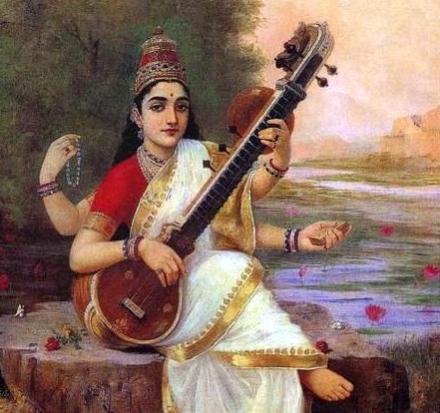
That the world’s largest festival takes place at the mythical site of the Saraswati River is not surprising. Saraswati is a river as well as its personification as a goddess. In the post-Vedic age, Saraswati began to lose her status as a river goddess and became increasingly associated with literature, arts, and music. In Hinduism, Saraswati represents intelligence, consciousness, cosmic knowledge, creativity, education, enlightenment, music, and the arts. In addition to her role as a goddess of learning, Saraswati is also known for her role as a guardian of Earth. In Buddhism, Saraswati is known as a guardian deity who upholds the teachings of Gautama Buddha by offering protection and assistance to practitioners.
Saraswati is associated with “anuraga”, the love for and rhythm of music, which represents all emotions and feelings expressed in speech or music. She is often depicted playing the vina (an ancient stringed instrument), which signifies the harmony of all mental strings, agencies, and attitudes.

In 2001, the last time the festival took place, more than 40 million people gathered in an area smaller than 7.7 sq. miles (or slightly larger than San Francisco). This year they are expecting over twice that number, making it the largest gathering of humanity ever held. Yet in spite of all the people and chaos, it is a peaceful event.
“The largest single gathering of people on Earth could hold the secret to how big communities can live together in harmony, according to researchers,” states the BBC.
Psychologists from St. Andrews, Dundee, and Lancaster Universities in the UK, along with several Indian institutions, completed a study in 2007 into the Kumbh Mela in Allahabad. What they found along the banks of the Ganges River overturned many long-held beliefs about crowd behavior.
The Kumbh Mela brings together the equivalent of over 20 times the population of the entire Bay Area in one place, yet there is virtually no disorder, crushes, or rioting. And even though people at the festival came from very different castes and social backgrounds, there was a strong sense of common identity. This positive outlook stemmed from a lack of the “them-and-us psychology” which is often at the root of social conflict.
Professor Steve Reicher, of St. Andrews University, said, “Despite the fact the Mela seems designed to increase stress in every way – it is very noisy day and night, very unhealthy, and very packed – what we found was that actually people feel serene, peaceful and unstressed. These various findings raise very important questions about the nature of collective participation and how it can affect both individual well-being and social cohesion.”
Dr. Clare Cassidy, also from St. Andrews University, stated that “many people argue crowds are bad for you. But in the Mela we found that people become more generous, more supportive, and more orderly rather than less. This is the opposite of a ‘walk-on-by society’, it is a community where people are attentive to the needs of strangers.”
“As well as academically interesting, the mela is visually amazing and an incredible event – like a vast biblical scene,” Professor Reicher explained. “The mela is much more than a wonderful spectacle. It promises to unlock the secrets of how large communities can live together in harmony”.
